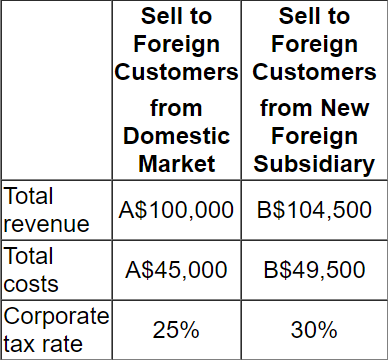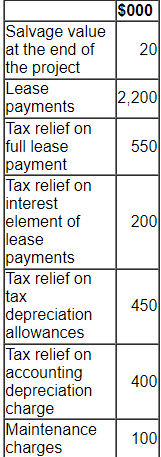CIMA F3 - Financial Strategy
A company is concerned about the interest rate that it will be required to pay on a planned bond issue.
It is considering issuing bonds with warrants attached.
Â
Advise the directors which of the following statements about warrants is NOT correct?
RST wishes to raise at least $40 million of new equity by issuing up to 10 million new equity shares at a minimum price of $3.00 under an offer for sale by tender. It receives the following tender offers:

What is the maximum amount that RST can raise by this share issue?
(Give your answer to the nearest $ million).

A company is considering either directly exporting its product to customers in a foreign country or setting up a subsidiary in the foreign country to manufacture and supply customers in that country.
Â
Details of each alternative method of supplying the foreign market are as follows:
 
Â
There is an import tax on product entering the foreign country of 10% of sales value.
This import duty is a tax-allowable deduction in the company's domestic country.
The exchange rate is A$1.00 = B$1.10
Â
Which alternative yields the highest total profit after taxation?
Company A has made an offer to acquire Company Z. Â
Both companies are quoted and their current market share prices are:
   • Company A - $4
   • Company Z - $5
Shareholders in company Z have been given three alternative offers:
   • Cash of $5.50 per share
   • Share for share exchange on the basis of 3 for 2
   • 10.5% long dated bond for every 20 shares
The bond is has a nominal value of $100 and the expected yield on bonds of similar risk is 10%.
Â
You are advising a Company Z shareholder on the three offers.
She requires a 15% premium if she is to accept the offer.Â
Â
In providing your advice, which of the following statements is correct?
A listed company follows a policy of paying a constant dividend. The following information is available:
   • Issued share capital (nominal value $0.50) $60 million
   • Current market capitalisation $480 million
The shareholders are requesting an increased dividend this year as earnings have been growing.  However, the directors wish to retain as much cash as possible to fund new investments. They therefore plan to announce a 1-for-10 scrip dividend to replace the usual cash dividend.
Â
Assuming no other influence on share price, what is the expected share price following the scrip dividend?
Â
Give your answer to 2 decimal places.
Â
$Â ? Â
A company is based in Country Y whose functional currency is YS. It has an investment in Country Z whose functional currency is ZS This year the company expects to generate ZS20 million profit after tax.
Tax Regime
• Corporate income tax rate in Country Y is 60%
• Corporate income tax rate in Country Z Is 30%
• Full double tax relief is available
Assume an exchange rate of YS1 = ZS5
What is the expected profit after tax in YS if the ZS profit is remitted to Country Y?
A project requires an initial outlay of $2 million which can be financed with either a bank loan or finance lease.
The company will be responsible for annual maintenance under either option.
Â
The tax regime is:
   • Tax depreciation allowances can be claimed on purchased assets.
   • If leased using a finance lease, tax relief can be claimed on the interest element of the lease payments and also on the accounting depreciation charge.
The trainee management accountant has begun evaluating the lease versus buy decision and has produced the following data. Â He is not confident that all this information is relevant to this decision.
  
Â
Using only the relevant data, which of the following is correct?
A company wishes to raise additional debt finance and is assessing the impact this will have on key ratios.Â
The following data currently applies:
   • Profit before interest and tax for the current year is $500,000
   • Long term debt of $300,000 at a fixed interest rate of 5%
   • 250,000 shares in issue with a share price of $8
The company plans to borrow an additional $200,000 on the first day of the year to invest in new project which will improve annual profit before interest and tax by $24,000.
The additional debt would carry an interest rate of 3%.
Assume the number of shares in issue remain constant but the share price will increase to $8.50 after the investment.
The rate of corporate income tax is 30%.
Â
After the investment, which of the following statements is correct?
A company is deciding whether to offer a scrip dividend or a cash dividend to its shareholders.Â
Although the company has excellent long-term growth prospects, it is experiencing short-term profit and cash flow problems.
Â
Which of the following statements is most likely to be a reason for choosing the scrip dividend?
F Co. is a large private company, the founder holds 60% of the company's share capital and her 2 children each hold 20% of the share capital.
The company requires a large amount of long-term finance to pursue expansion opportunities, the finance is required within the next 3 months. The family has agreed that an Initial Public Offering (IPO) should not be pursued at this time, because it would take up to 12 months to arrange.
The existing shareholders are currently considering raising the required finance from an established Venture Capitalist in the form of debt and equity. The Venture Capitalist has agreed to provide the required finance provided it can earn a return on investment of 25% per year. In addition, the Venture Capitalist requires 60% of the equity capital, a directorship in the company and a veto on all expenditure of a capital or revenue nature above a specified limit.
From the perspective of the family, which of the following are advantages of raising the required finance from the Venture Capitalist?
Select all that apply.




